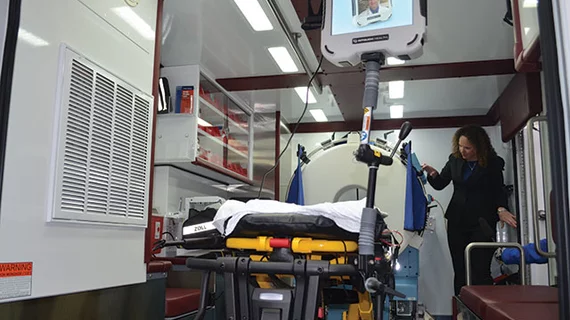Stroke centers may be penalized for accepting sicker transfer patients
Risk-adjustment models assessing hospitals’ stroke outcomes should include patient transfer status, argue the authors of a new study, who found centers that accepted more transfer patients treated a sicker population and experienced higher mortality rates.
“Advanced stroke care centers provide specialized care and offer advanced interventions, such as endovascular thrombolysis or thrombectomy, neurosurgical interventions, and dedicated neurointensive care requiring specialized infrastructure and personnel,” corresponding author Lee Schwamm, MD, with the department of neurology at Massachusetts General Hospital, and colleagues wrote in Circulation: Cardiovascular Quality and Outcomes.
“The natural concentration of these patients with severe strokes and those immediately post-intravenous tissue-type plasminogen activator at specialized stroke care centers has raised concerns about whether such centers are unfairly assessed by public reporting programs that seek to measure mortality and morbidity at discharge.”
The authors studied more than 970,000 cases of out-of-hospital, acute ischemic stroke that were treated by centers participating in the Get With the Guidelines-Stroke registry. Eighty-seven percent of patients presented directly to emergency rooms, while the remaining 13 percent were transferred from another hospital.
Compared to “front-door” patients, transferred patients had higher National Institutes of Health Stroke Scale (NIHSS) scores (median 6 versus 4) and were more likely to die in the hospital (7.9 percent mortality versus 4.9 percent).
“Because transfer-in patients have more severe disability at onset and worse outcomes at discharge, these transfer-in patients have the potential to negatively influence performance on outcomes measures at the referral centers at which they are more concentrated,” the authors wrote, noting NIHSS scores have been shown to be “the strongest single predictor of in-hospital mortality.”
After the acute phase of care, adherence to stroke performance measures between hospitals accepting a low versus a high number of transfer patients was similar, making it more likely the severity of disability upon hospital arrival was the key driver of mortality differences.
Schwamm et al. said it’s important to treat the most severe patients at centers with the staff and resources to offer advanced interventions. But they warned if risk-adjustment models don’t account for NIHSS and transfer status, it could “create perverse incentives for specialized stroke centers to discourage transfer of the sickest patients who are precisely those most in need of their services.”
In a related editorial, Shyam Prabhakaran, MD, agreed with the researchers’ concerns that certain centers may have unfairly inflated mortality rates. He said policymakers and hospital administrators should consider those factors, but noted it’s also important to explore how delays in treatment for transferred patients may contribute to the higher mortality rates.
Prabhakaran said prior studies demonstrate time spent at initial hospitals accounts for up to two-thirds of the period before a patient reaches a comprehensive stroke center (CSC). Potential efforts to streamline care, he wrote, include:
- A direct-to-CT process to reduce door-to-needle times and assess for large-vessel occlusions at the primary stroke center.
- Improved communication between centers, including a direct hotline to contact the CSC upon patient arrival and the use of telestroke technology at the primary center so more experienced clinicians can help with diagnoses and ready the CSC care team for a transfer, if necessary.
- Simplifying documentation and checklist protocols for paramedics.
- Transferring health record information, including imaging data, electronically, and providing electronic updates from the ambulance to the CSC team members during transit.
“The best model of care is still unknown, wrote Prabhakaran, MD, with the Northwestern University Feinberg School of Medicine. “A better understanding of the ins and outs of doors in stroke care will be a big step towards ensuring that the right patients are treated at the right centers and the right time.”

